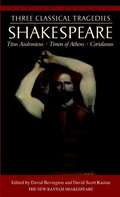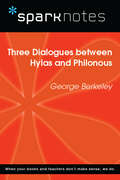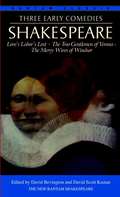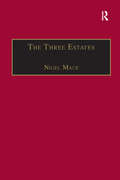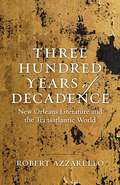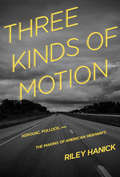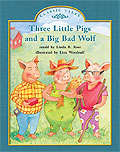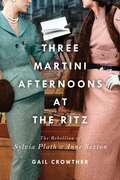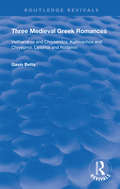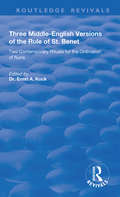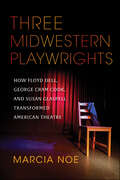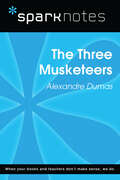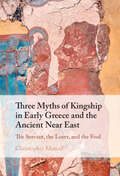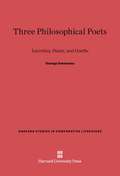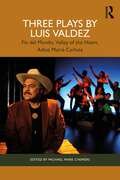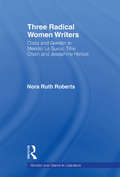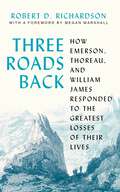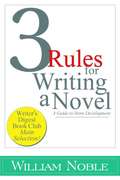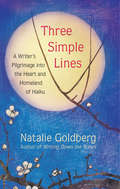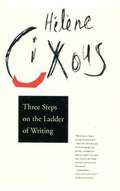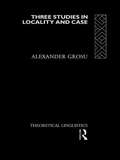- Table View
- List View
Three Classical Tragedies: Titus Andronicus, Timon of Athens, Coriolanus
by William Shakespeare David M. Bevington David Scott KastanTitus Andronicus * Timon of Athens * Coriolanus. Each Edition Includes: Comprehensive explanatory notes placed on pages facing the text of the play, vivid introductions and the most up-to-date scholarship, and clear, modernized spelling and punctuation, enabling contemporary readers to understand the Elizabethan English. Completely updated, detailed bibliographies and performance histories. An interpretive essay on film adaptations of the play, along with an extensive filmography. Titus Andronicus, Shakespeare's earliest tragedy, is also his bloodiest and most horror-filled. A Roman general, to appease the spirit of his dead son, sacrifices the son of a captive Goth queen--and sets in motion a remorseless cycle of revenge and counterrevenge. The play's vivid spectacle of violence stuns audiences with rape, murder, mutilation, and unmitigated cruelty. Timon of Athens, a stark drama--in some ways Shakespeare's most bitter play--is a brilliant psychological portrait of a wealthy Athenian lord whose extraordinary trust and love for others turns to hate and spite when, bankrupted by his generosity, he is overwhelmed by the indifference and ingratitude of those he had thought friends. Coriolanus, the arrogance of a Roman military hero puts him in conflict with the people of Rome when the aristocrat is unwilling to compromise with the commoners he so despises. Compellingly relevant today, Shakespeare's last tragedy--from its opening scene of popular unrest to its chilling climax of betrayal and murder--takes an unwavering, ironic look at political extremism.
Three Dialogues between Hylas Philonous (SparkNotes Philosophy Guide)
by SparkNotesThree Dialogues between Hylas Philonous (SparkNotes Philosophy Guide) Making the reading experience fun! SparkNotes Philosophy Guides are one-stop guides to the great works of philosophy–masterpieces that stand at the foundations of Western thought. Inside each Philosophy Guide you&’ll find insightful overviews of great philosophical works of the Western world.
Three Early Comedies: Love's Labor's Lost, The Two Gentlemen of Verona, The Merry Wives of Windsor
by William Shakespeare David Bevington David Scott Kastan James Hammersmith Robert Kean Turner Joseph PappThree Early Comedies: Love's Labor's Lost Farce and fun follow when a young king and his three friends vow to give up women for a year--just as a pretty princess and her three ladies-in-waiting arrive--in a delightful play that ends with one of Shakespeare's loveliest songs. The Two Gentlemen of Verona: In this lyrical comedy, two friends are infatuated with the same woman, while a jilted girl disguised as a boy and a clownish servant with a raffish mutt set the scene for laughter and a timeless story of love. The Merry Wives of Windsor: Shakespeare's famous rogue, Falstaff, woos two married women with identical love letters--and becomes the focus of a hilarious comedy when the women conspire to teach him a lesson.
The Three Estates: A Pleasant Satire in Commendation of Virtue and in Vituperation of Vice
by Nigel MaceThis is the first ever English translation of Sir David Lindsay’s masterpiece of 16th-century Scottish political theatre, Ane Pleasant Satyre of the Thrie Estaitis in Commendatioun of Vertew and Vituperatioune of Vyce. The work’s importance lies in its status as a well-known piece of national literature, and as a historical document of interest to historians of Scottish and European court politics.The verse translation available here is of over 3,000 lines, in an edition which combines a historical and critical introduction with the possibilities of modern performance. Besides issues of text and translation, the introduction examines the background of Scotland in 1552, the author and his audience, the play’s performance history and its position as a Renaissance text. A work on a grand scale with a cast of over 40, the play confronts and resolves the ill-counselled, misrule of young King Humanity through the intervention, not only of King Correction and of learned contemporaries, but also through the fearless condemnations of the Poor Man and the political resolution of John The Common Weal. Its conclusions are humanly centred, popularly representative and yet strikingly realistic. They, and their manner of expression, make an ideal object for the study of a society poised between the pluralism of the Renaissance and the rigour of the Reformation.
Three Great Ballplayers
by Greg RogersThe fun and excitement of English and Language Arts learning continues in Grade 2 of Reading Street. This comprehensive and dynamic curriculum for homeschooling is geared toward young children who have some foundational English and Language Arts knowledge and are ready to strengthen their skills. Comprised of engaging activities, challenging content and weekly quizzes, Reading Street: Grade 2 is the next step in your child's path toward becoming a lifelong learner and reader. As with all Reading Street products, the Grade 2 system is formatted to help students meet certain age-appropriate goals. After completing this English and Language Arts homeschool program, your child should be able to: Read and comprehend two-syllable words. Identify common prefixes (such as pre-, un-, or re-) and suffixes (such as -able, -ad and -er). Correct mistakes made when reading out loud. Read books with two or more chapters. Understand the structure of stores (i. e. beginning, middle and end). Start selecting reading materials based on his/her own interests. Identify the "who," "what," "when," "where," "why" and "how" of the text. While the goals of second Grade English and Language Arts are numerous, Reading Street will help you craft engrossing lessons. Your child will garner important English and Language Arts skills while completing a workbook, reading stories and poems, and taking assessments. Planning these lessons will be easier than ever, as all Reading Street systems are broken down into weekly Big Ideas. All the work your child does on a given week is formulated around that single concept for an organized and challenging curriculum. With six easy-to-follow units, Reading Street: Grade 2 is the perfect tool for homeschooling parents. Your child will enjoy the reading selections and activities, and you'll love to see your student growing into a knowledgeable individual. We're confident that this product is the right one for you. For more information on the specific materials found in Grade 2 of Reading Street, check out the Features and Benefits page.
Three Hundred Years of Decadence: New Orleans Literature and the Transatlantic World
by Robert AzzarelloNew Orleans’s reputation as a decadent city stems in part from its environmental precariousness, its Francophilia, its Afro-Caribbean connections, its Catholicism, and its litany of alleged “vices,” encompassing prostitution, miscegenation, homosexuality, and any number of the seven deadly sins. An evocative work of cultural criticism, Robert Azzarello’s Three Hundred Years of Decadence argues that decadence can convey a more nuanced meaning than simple decay or decline conceived in physical, social, or moral terms. Instead, within New Orleans literature, decadence possesses a complex, even paradoxical relationship with concepts like beauty and health, progress, and technological advance. Azzarello presents the concept of decadence, along with its perception and the uneasy social relations that result, as a suggestive avenue for decoding the long, shifting story of New Orleans and its position in the transatlantic world. By analyzing literary works that span from the late seventeenth century to contemporary speculations about the city’s future, Azzarello uncovers how decadence often names a transfiguration of values, in which ideas about supposed good and bad cannot maintain their stability and end up morphing into one another. These evolving representations of a decadent New Orleans, which Azzarello traces with attention to both details of local history and insights from critical theory, reveal the extent to which the city functions as a contact zone for peoples and cultures from Europe, Africa, and the Americas. Drawing on a deep and understudied archive of New Orleans literature, Azzarello considers texts from multiple genres (fiction, poetry, drama, song, and travel writing), including many written in languages other than English. His analysis includes such works of transcription and translation as George Washington Cable’s “Creole Slave Songs” and Mary Haas’s Tunica Texts, which he places in dialogue with canonical and recent works about the city, as well as with neglected texts like Ludwig von Reizenstein’s German-language serial The Mysteries of New Orleans and Charles Chesnutt’s novel Paul Marchand, F.M.C. With its careful analysis and focused scope, Three Hundred Years of Decadence uncovers the immense significance—historically, politically, and aesthetically—that literary imaginings of a decadent New Orleans hold for understanding the city’s position as a multicultural, transatlantic contact zone.
Three in One: Analogies for the Trinity
by William David SpencerDo our images of "one God in three persons" reflect God well?Throughout history, Christians have pictured the relationships between Father, Son, and Holy Spirit through analogies. Such illustrations--some from the West but also from Latin America, Asia, Africa, and other places--come laden with theological ramifications that the church has rejected (heresies) or embraced (doctrines). In Three in One, William David Spencer shares a lifetime of insights from teaching within the global church, bringing fresh images and analogies of the Trinity to deepen our theological vocabulary.Drawing from his extensive teaching in geographically and culturally diverse contexts and his artist's passion for evocative words and visuals, Spencer offers readers a rich, multifaceted, and practical exploration of the Trinity. Alongside historical and contemporary theology and biblical studies, he considers the strengths and shortcomings of various analogies used to explain the Trinity, such as:LightWaterThe Celtic knotThe totem poleMusical harmoniesThe human bodyThe familyReaders of Three in One will gain a personal understanding of the Trinity as well as tools for teaching about the Trinity in adult and children's ministry contexts.
Three Kinds of Motion: Kerouac, Pollock, and the Making of American Highways
by Riley Hanick"Like a great conversationalist, Hanick paints a generous canvas, and I rode the length of this powerful book much like I first experienced the American interstate: songs on the stereo, windows down, and the bittersweet sense that youth is fleeting. Three Kinds of Motion holds open a wild and beautiful journey, not to be missed."--Thalia FieldIn 1943, Peggy Guggenheim commissioned a mural from Jackson Pollock to hang in the entryway of her Manhattan townhouse. It was the largest Pollock canvas she would ever own, and four years later she gave it to a small Midwestern institution with no place to put it. When the original scroll of On the Road goes on tour across the country, it lands at the same Iowa museum housing Peggy's Pollock, revitalizing Riley Hanick's adolescent fascination with the author. Alongside these two narrative threads, Hanick revisits Dwight D. Eisenhower's quest to build America's first interstate highway system. When catastrophic rains flood the Iowa highways with their famous allure and history of conquest, they also threaten the museum and its precious mural. In Three Kinds of Motion, his razor-sharp, funny, and intensely vulnerable book-length essay, Hanick moves deftly between his three subjects. He delivers a story with breathtaking ingenuity.Riley Hanick is an essayist, journalist, and translator. His work has received support from the Jentel and McKnight foundations and he has served as a writer-in-residence for the University of Iowa Museum of Art. He teaches at Murray State University.
Three Little Pigs and a Big Bad Wolf (Fountas & Pinnell LLI Green #Level E, Lesson 61)
by Linda RossFountas and Pinnell Leveled Literacy Intervention Green System -- 1st Grade
Three-Martini Afternoons at the Ritz: The Rebellion of Sylvia Plath & Anne Sexton
by Gail CrowtherA vividly rendered and empathetic exploration of how two of the greatest poets of the 20th century—Sylvia Plath and Anne Sexton—became bitter rivals and, eventually, friends. Introduced at a workshop in Boston University led by the acclaimed and famous poet Robert Lowell, Sylvia Plath and Anne Sexton formed a friendship that would soon evolve into a fierce rivalry, colored by jealousy and respect in equal terms. In the years that followed, these two women would not only become iconic figures in literature, but also lead curiously parallel lives haunted by mental illness, suicide attempts, self-doubt, and difficult personal relationships. With weekly martini meetings at the Ritz to discuss everything from sex to suicide, theirs was a relationship as complex and subversive as their poetry. Based on in-depth research and unprecedented archival access, Three-Martini Afternoons at the Ritz is a remarkable and unforgettable look at two legendary poets and how their work has turned them into lasting and beloved cultural figures.
Three Medieval Greek Romances: Velthandros And Chrysandza, Kallimachos And Chrysorroi, Livistros And Rodamni (Routledge Revivals #Vol. 98b)
by Gavin BettsPublished in 1995: These three 14th century medieval Greek romances, which are presented here for the first time in English translation, form part of a curious and previously neglected corner of literature.
Three Middle-English Versions of the Rule of St. Benet: Two Contemporary Rituals for the Ordination of Nuns (Routledge Revivals)
by Ernst A. KockFirst published in 1902, this volume contains an extensive, technical scholarly introduction, followed by three Middle-English versions of the Rule of St. Benet along with the Northern Lansdowne Ritual on the reception of novices and the Vespasian Ritual of making a nun. As St Benet is the Medieval English version of St. Benedict, the original version of this text dates back to the 6th century.
Three Midwestern Playwrights: How Floyd Dell, George Cram Cook, and Susan Glaspell Transformed American Theatre
by Marcia NoeIn the early 1900s, three small-town midwestern playwrights helped shepherd American theatre into the modern era. Together, they created the renowned Provincetown Players collective, which not only launched many careers but also had the power to affect US social, cultural, and political beliefs.The philosophical and political orientations of Floyd Dell, George Cram Cook, and Susan Glaspell generated a theatre practice marked by experimentalism, collaboration, leftist cultural critique, rebellion, liberation, and community engagement. In Three Midwestern Playwrights, Marcia Noe situates the origin of the Provincetown aesthetic in Davenport, Iowa, a Mississippi River town. All three playwrights recognized that radical politics sometimes begat radical chic, and several of their plays satirize the faddish elements of the progressive political, social, and cultural movements they were active in.Three Midwestern Playwrights brings the players to life and deftly illustrates how Dell, Cook, and Glaspell joined early 20th-century midwestern radicalism with East Coast avant-garde drama, resulting in a fresh and energetic contribution to American theatre.
The Three Musketeers (SparkNotes Literature Guide Series)
by SparkNotesThe Three Musketeers (SparkNotes Literature Guide) by Alexandre Dumas Making the reading experience fun! Created by Harvard students for students everywhere, SparkNotes is a new breed of study guide: smarter, better, faster. Geared to what today's students need to know, SparkNotes provides: *Chapter-by-chapter analysis *Explanations of key themes, motifs, and symbols *A review quiz and essay topicsLively and accessible, these guides are perfect for late-night studying and writing papers
Three Myths of Kingship in Early Greece and the Ancient Near East: The Servant, the Lover, and the Fool
by Christopher MetcalfOn the basis of recently discovered sources and original research, this book identifies and analyses three story-patterns associated with human kingship in early Greek and ancient Near Eastern myth. The first of these, the 'Myth of the Servant', was used to explain how an individual of non-royal lineage rose to power from obscure origins. The second myth, on the 'Goddess and the Herdsman', made the fundamental claim that the ruler engaged in a sexual relationship with a powerful female deity. Third, although kings are often central to the ancient literary evidence, the texts themselves were usually authored by others, such as poets, priests, prophets or scholars; like kings, these characters similarly tended to base their authority on their ability to articulate and enact the divine will. The stage was thus set for narratives of conflict between kings and other intermediaries of the gods.
Three Philosophical Poets: Lucretius, Dante, and Goethe
by George SantayanaThis book provides an introduction to the three great philosophical poets whose works taken together possibly sum up all European philosophy.
Three Plays by Luis Valdez: Fin del Mundo, Valley of the Heart, Adíos Mamá Carlota
by null Luis ValdezCollecting together Fin del Mundo, Valley of the Heart, and Adíos Mamá Carlota, this book compiles the latest plays of Luis Valdez and explores how they stand to be considered masterpieces by the man who brought the world Zoot Suit and La Bamba.Luis Valdez has been described as the “last of the great American playwrights,” referring to a Golden Age of U.S. playwriting that began with Eugene O’Neill and included Tennessee Williams, Arthur Miller, and August Wilson. Like these other playwrights, Valdez’s impact on theatre needs to be measured on a global scale. The plays are psychologically deep, with powerful political messages woven into sophisticated plots and minutely drawn characters, all done with the characteristic rasquachi theatricality that made Valdez a household name. Fin del Mundo follows the protagonist through a maze-like urban afterlife that is by turns hilarious and deeply moving. In Valley of the Heart we witness a fictionalization of the true history of the relationship of Chicanos to Japanese-Americans during the horrific internments of World War II. Finally, in Adíos Mamá Carlota, we share the final moments of the former Empress of Mexico, teetering on the edge of madness, as she relives her extraordinary life and faces crippling guilt over her actions. Together, these plays represent a crowning achievement in the storied life of Luis Valdez. In this collection, each play is preceded by an introductory chapter by Jorge A. Huerta with analysis of the play.This collection is a vital and indispensable text for practitioners and students, as well as scholars of contemporary theatre, American, and Chicano performance.
Three Radical Women Writers: Class and Gender in Meridel Le Sueur, Tillie Olsen, and Josephine Herbst (Gender and Genre in Literature #6)
by Nora Ruth RobertsCombining biography, history, and literary theory, this work looks at three of the most significant women writers to emerge from American radicalism of the 1930s. Le Sueur, Olsen, and Herbst were influenced by the Communist movement of the time, but each also forged an independent vision of feminist socialist literary milieu. Drawing on Marxist and post-Marxist theory, and addressing the challenge of such new feminist theorists as Jean Bethke Elshtain, Roberts takes a theoretical approach that encompasses the social vision and feminist practice of the writers and places them in their historical, cultural, and social contexts. The study covers their lives from the turn of the century to the 1970s, with an emphasis on the 1930s; examines their views of the Cold War; links the three to the Progressive tradition; and analyzes their key literary works. Resources for analysis include historical and contemporary theory; excerpts from the radical press of the 1920s and 1930s; and primary materials from the writers themselves, including journals, notes, and unpublished archival materials.
Three Roads Back: How Emerson, Thoreau, and William James Responded to the Greatest Losses of Their Lives
by Robert D. RichardsonFrom their acclaimed biographer, a final, powerful book about how Emerson, Thoreau, and William James forged resilience from devastating loss, changing the course of American thoughtIn Three Roads Back, Robert Richardson, the author of magisterial biographies of Ralph Waldo Emerson, Henry David Thoreau, and William James, tells the connected stories of how these foundational American writers and thinkers dealt with personal tragedies early in their careers. For Emerson, it was the death of his young wife and, eleven years later, his five-year-old son; for Thoreau, it was the death of his brother; and for James, it was the death of his beloved cousin Minnie Temple. Filled with rich biographical detail and unforgettable passages from the journals and letters of Emerson, Thoreau, and James, these vivid and moving stories of loss and hard-fought resilience show how the writers’ responses to these deaths helped spur them on to their greatest work, influencing the birth and course of American literature and philosophy.In reaction to his traumatic loss, Emerson lost his Unitarian faith and found solace in nature. Thoreau, too, leaned on nature and its regenerative power, discovering that “death is the law of new life,” an insight that would find expression in Walden. And James, following a period of panic and despair, experienced a redemptive conversion and new ideas that would drive his work as a psychologist and philosopher. As Richardson shows, all three emerged from their grief with a new way of seeing, one shaped by a belief in what Emerson called “the deep remedial force that underlies all facts.”An inspiring book about resilience and the new growth and creativity that can stem from devastating loss, Three Roads Back is also an extraordinary account of the hidden wellsprings of American thought.
Three Rules for Writing a Novel: A Guide to Story Development
by William NobleFrom the standpoint that every novel is unique, Maugham had a point. But, are there fundamentals inherent in writing long-form fiction? <p><p> Yes.
Three Simple Lines: A Writer’s Pilgrimage into the Heart and Homeland of Haiku
by Natalie GoldbergOne of the world&’s foremost writing teachers invites readers on a joyful journey into the reading and origins of haiku A haiku is three simple lines. But it is also, as Allen Ginsberg put it, three lines that &“make the mind leap.&” A good one, he said, lets the mind experience &“a small sensation of space which is nothing less than God.&” As many spiritual practices seek to do, the haiku&’s spare yet acute noticing of the immediate and often ordinary grounds the reader in the pure awareness of now. Natalie Goldberg is a delightfully companionable tour guide into this world. She highlights the history of the form, dating back to the seventeenth century; shows why masters such as Basho and Issa are so revered; discovers Chiyo-ni, an important woman haiku master; and provides insight into writing and reading haiku. A fellow seeker who travels to Japan to explore the birthplace of haiku, Goldberg revels in everything she encounters, including food and family, painting and fashion, frogs and ponds. She also experiences and allows readers to share in the spontaneous and profound moments of enlightenment and awakening that haiku promises.
Three Steps on the Ladder of Writing
by Helene Cixous Susan Sellers Sarah CornellThree Steps on the Ladder of Writing is a poetic, insightful, and ultimately moving exploration of 'the strange science of writing. ' In a magnetic, irresistible narrative, Cixous reflects on the writing process and explores three distinct areas essential for 'great' writing: The School of the Dead-the notion that something or someone must die in order for good writing to be born; The School of Dreams-the crucial role dreams play in literary inspiration and output; and The School of Roots-the importance of depth in the 'nether realms' in all aspects of writing. Cixous's love of language and passion for the written word is evident on every page.
Three Studies in Locality and Case (Theoretical Linguistics Ser.)
by Alexander GrosuFirst Published in 2004. Routledge is an imprint of Taylor & Francis, an informa company.
The Three Sustainabilities: Energy, Economy, Time
by Allan StoeklBringing the word sustainability back from the brink of cliché—to a substantive, truly sustainable future Is sustainability a hopelessly vague word, with meager purpose aside from a feel-good appeal to the consumer? In The Three Sustainabilities, Allan Stoekl seeks to (re)valorize the word, for a simple reason: it is useful. Sustainability designates objects in time, their birth or genesis, their consistency, their survival, their demise. And it raises the question, as no other word does, of the role of humans in the survival of a world that is quickly disappearing—and perhaps in the genesis of another world. Stoekl considers a range of possibilities for the word, touching upon questions of object ontology, psychoanalysis, urban critique, technocracy, and religion. He argues that there are three varieties of sustainability, seen from philosophical, cultural, and economic perspectives. One involves the self-sustaining world &“without us&”; another, the world under our control, which can run the political spectrum from corporatism to Marxism to the Green New Deal; and a third that carries a social and communitarian charge, an energy of the &“universe&” affirmed through, among other things, meditation and gifting. Each of these carves out a different space in the relations between objects, humans, and their survival and degradation. Each is necessary, unavoidable, and intimately bound with, and infinitely distant from, the others.Along the way, Stoekl cites a wide range of authors, from philosophers to social thinkers, literary theorists to criminologists, anthropologists to novelists. This beautifully written, compelling, and nuanced book is a must for anyone interested in questions of ecology, energy, the environmental humanities, contemporary theories of the object, postmodern and posthuman aesthetics, or religion and the sacred in relation to community.
